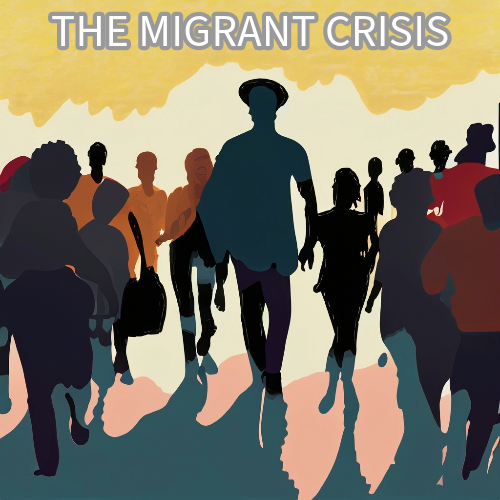The migrant crisis, marked by staggering numbers and poignant tales of human endurance, has become a defining issue of our time. As of 2021, an estimated 82 million people were forcibly displaced worldwide, a figure that eclipses the entire population of Germany. While migrants have always been a part of human history, the scale and complexity of recent movements have presented unprecedented challenges for host countries. The United States, Europe, and Canada have all grappled with the influx of migrants, facing both humanitarian imperatives and domestic pressures.
Migrant Origins
Migrants often come from countries marked by conflict, economic instability, and lack of opportunities. In the US, Customs and Border Protection reported encountering over 180,000 migrants at the southern border in May 2021 alone, a 20-year high. And in September 2023, according to CBS News 140,000 crossed the U.S.-Mexico border without authorization in the first 20 days of September 2023. Europe, meanwhile, witnessed over one million sea arrivals in 2015 during the peak of the Syrian crisis. Canada, traditionally more welcoming, saw a threefold increase in asylum claims between 2015 and 2019.
Overwhelmed Systems
The sheer volume of migrants has placed tremendous strain on the immigration systems of host countries. Detention facilities in the US, for instance, have been overwhelmed, leading to concerns about the treatment and well-being of detainees. In 2019, the notorious Moria camp in Greece, built for 3,000, swelled to over 20,000 occupants. Canada, while seeing fewer numbers, still faced backlogs where some asylum seekers had to wait up to two years for their claims to be processed.
The Irony of Virtue Signalling
Certain Democratic states in the US have proclaimed themselves as sanctuaries for migrants. Initially, this was a bold statement against federal immigration policies deemed harsh. Cities like San Francisco and Los Angeles vowed to protect migrants from deportation.
However, by 2019, Los Angeles County had seen a 12% rise in homelessness, with some attributing the strain, in part, to the migrant influx.
And most recently in September 2023, we have New York Mayor Eric Adams saying that migrants could destroy New York City, a far cry from his welcoming message not too long ago.
The challenge of managing large numbers of migrants underscored that symbolic gestures, no matter how well-intentioned, often fall short in the face of real-world complexities.
Europe’s Stopgap Measures
Some European Union nations have resorted to funding countries like Turkey to deter or contain migrant flows. The EU-Turkey deal in 2016 involved an agreement of €6 billion to Turkey to curb migration. While this approach might provide short-term relief, it’s not a sustainable solution. Such payments can potentially end up in the hands of regimes or militias with questionable human rights records, exacerbating the very problems that cause migration.
Toronto’s Own Migrant Crisis
On February 22, 2013, Toronto City Council voted 37-3 to adopt a formal policy of allowing undocumented migrants to access city services, effectively becoming a “sanctuary city”.
However, as other countries started to tighten their borders, Canada, especially Toronto became the next destination for the migrants to come to as the news was out that we welcome everyone. (Not that we don’t, but we need to do it in a controlled sustainable manner for the locals and resources available). This proclamation soon came to haunt Toronto, it suddenly realized this might be a mistake.
Just this year in July 2023, Toronto saw its own migrant challenge as reported by CTV News.
TORONTO SHELTERS SEE 440 PER CENT JUMP IN REFUGEES SINCE 2001
According to the city, there were 2,900 refugee claimants in Toronto’s shelter system in May. That’s an increase of 440 per cent compared to September 2021, when there were just 537.While the city funds 500 beds for refugees at a cost of $34 million, it says it needs more than $100 million in federal funding to cover the remaining demand.
‘I feel like I’m not welcome’: Refugees describe ‘crisis’ on Toronto’s streets – CTV News Toronto – uly 14, 2023 2:27 p.m. EDT
With Toronto’s budget deficit of an estimated $1.5 billion starting in 2024 and our own housing crisis where people are living in tents city at Allan Garden at Carlton Street and Sherbourne Street. How much more can Torontonians handle before an uprising? Toronto is a multicultural and welcoming city, but yelling to the world that we are a sanctuary city has its consequences.
Cultural Challenges and Adjustments
While migration brings with it tales of hope and perseverance, it also presents challenges tied to cultural integration. Adult migrants, more set in their ways and traditions, often find it harder to adjust to the local culture compared to younger children who are more adaptable. This disparity can lead to cultural clashes that breed resentment both from the local population and the migrants themselves. Such tensions sometimes manifest as racism or prejudice, further complicating the integration process.
Given these complexities, there’s an argument to be made about the exclusion of older migrants from host countries unless they are fleeing war zones or situations beyond their control. The idea behind this stance is to prioritize cultural harmony and societal cohesion.
Migration is a multifaceted issue that demands sensitive handling and deep understanding. While the spirit of humanity calls for welcoming those in need, it’s also essential to acknowledge the challenges that come with blending diverse cultures.
Those considering migration, unless for vacation or transient purposes, should be willing to adapt and embrace the culture of their host country. Imposing one’s culture on a host community is not just counterproductive but also unacceptable behavior.
True success in migration lies not just in the movement of people but in the harmonious merging of cultures and values.
What’s the Solution to the Migrant Crisis?
The real solution to the migrant crisis is to make the migrant’s home country a place where they want to stay. The United Nations along with the United States, Canada, and the European Union should work to resolve this in a coordinated effort.
Some of the problems with migrants’ origin countries are a result of the foreign policies enacted by the United States and other advanced countries in the use of economic tools such as sanctioning those countries. Economic sanction makes ordinary people’s lives very difficult and does very little to inflict pain on the government they don’t like.
As a result, advanced countries fail to adequately look at the effects of what those sanctions have done, in this case, an unprecedented influx of migrants banging on your doorstep.




